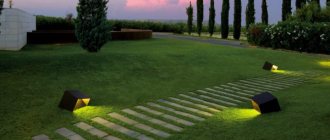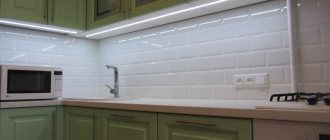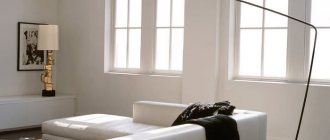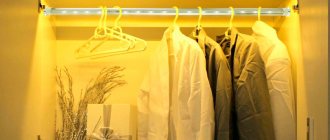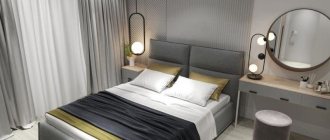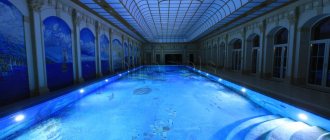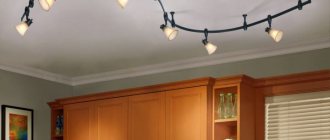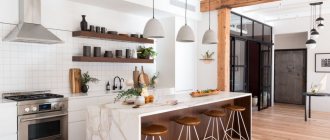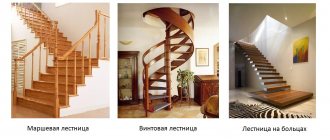Household lamps working with LED lamps appeared on the market relatively recently, in the early 2000s. Before this, LEDs were used mainly in devices and for industrial needs. Despite the comparative high cost, buyers appreciated both the interesting appearance of the new products and the possibilities opened up for interior design. With increasing sales and decreasing prices for this type of product, the popularity of LED lamps has only increased.
Today they are readily purchased for private houses and apartments, for hotels and catering establishments. In almost any municipal institution or office you can find LED lighting fixtures. Their main advantage over other types of light sources is high luminous efficiency with low energy consumption. Consequently, the load on the power grid is significantly reduced, and property owners and tenants save on electricity bills.
However, efficiency is far from the most important aspect of the popularity of LEDs. The main reason lies in the highest, unique decorative and aesthetic qualities of the lamps. Manufacturers annually present dozens of new models made in the original design. You can easily find products that meet the most specific needs and refined, demanding tastes. Realize fantastic projects and incredible ideas with their help. How to do it? Our interior design experts will advise you.
LED lamps in different rooms
The range of modern LED lighting products is very large. Designers, in close collaboration with designers, are developing new product lines intended for use in certain rooms - the hall, the kitchen, the office. Of course, the installation location of the product is given for informational purposes, in no way limiting the wishes of consumers. If the buyer is sure that this model will look amazing in the bedroom, the manufacturers’ recommendations can be safely ignored. The only exceptions are lamps for “wet areas”, such as the bathroom, swimming pool, and the area near the kitchen sink. Such products are subject to increased IP level requirements.
So, which lamps to choose for different rooms, and how to combine them?
Living room
The main hall, which is the “calling card” of the house, is strongly associated with a luxurious chandelier. She literally reigns in the room, attracting close attention, creating a special atmosphere. Depending on the tastes of the owners and the chosen style, you can choose different options:
- respectable classics with crystal pendants, glass shades and an elaborate hanging frame. Such a lamp creates a feeling of prosperity, reliability, and gives the room a formal look;
- discreet, laconic forms that serve as a discreet addition to the overall atmosphere. The chandelier serves as the finishing touch for such trends as minimalism, Scandinavian;
- fantastic design, emphasizing the special tastes and character traits of the owners.
If the height of the ceilings and the dimensions of the room do not allow the use of large chandeliers, you should pay attention to ceiling and recessed lamps. Also, these types of lighting devices are recommended for installation on suspended and multi-level plasterboard ceilings. They are more compact, do not have long rods or suspensions, so they are mounted directly on the ceiling, leaving enough free space below. At the same time, the products are no less impressive and serve as a wonderful decoration for the room.
For a spacious room like a living room, a single chandelier or ceiling light is not enough. Additional lighting required. This can be done using the following models:
- spot lighting for ceilings, walls and floors;
- wall sconces;
- luminous paintings and clocks, lightboxes;
- LED strips of various colors;
- table and floor lamps.
Different types of lighting fixtures help place the right accents. For example, to draw attention to an artistic canvas or a collection of rarities, or to create a pleasant twilight in the recreation area. They make the interior brighter and richer. And the different color temperatures of the lamps and the color of the light fluxes create absolutely fantastic effects.
You can combine lighting fixtures in the living room in different ways, completely letting your imagination run wild. However, it is worth considering several rules.
- The central ceiling lamp sets the tone for the entire composition; it is this that people focus on when purchasing additional lighting.
- You can ignore this tradition by simply abandoning the chandelier. Modern technologies make it possible to replace it with spot lighting and LED strips located around the perimeter. This is how the effect of a “starry sky”, illuminated paintings, and stained glass windows is achieved.
- To create directed, accentuated rays of light, spots or track systems are used.
In addition, it is not recommended to randomly mix different colors - such decor has an irritating or depressing effect. It is better to choose shades of your favorite color, or decorate the room in colors that match each other.
Types of Natural Light
Natural lighting by its nature is the most appropriate for both residential and office spaces. Natural - does not flicker, the eyes do not get tired, color rendition remains without distortion, and no electrical energy is consumed. Sunlight illuminates and warms the room - its presence fills the room with an atmosphere of coziness and comfort.
Over the entire period of the existence of culture and the development of civilization, humanity has developed several ways to illuminate rooms with natural light.
Types (types) of natural lighting.
Conventionally, these techniques can be divided into three types of natural lighting: side (a, b), top (c) and combined (d).
Lateral - enters the room through window openings, directly depends on the number of windows. In any case, even with large windows, by the middle of the room the sunlight is reduced by 50%, and it simply does not reach the opposite wall.
Advice : If your house is being built according to an individual project, then it is quite possible to make a larger window opening or place more windows on the southeast side of the building.
The top one - descends from the ceiling, is considered ideal and its use provides the most complete penetration of light into all corners of the space. To provide natural light through the ceiling, it is necessary to include in the project the use of special glasses and structures that allow this project to be implemented. In addition, it should be remembered that this method is only suitable for the top floor of a building or in one-story construction.
Combined - it is considered the most successful to combine the available methods of light supply, which takes into account all possible options in this particular project. When using combined methods, it is worth paying attention not only to the light transmission of glass, but also to energy-saving technologies, since window openings, especially in the ceiling, consume heat from the house.
Kitchen
This room places the highest demands on lighting. If the lack of artificial light in the living room is not a fatal mistake, then in the kitchen incorrectly installed lighting causes a lot of inconvenience. Thus, light rays directed from behind and from above relative to a standing person give a thick shadow to the working surface. As a result, you have to strain your eyes, lean lower over the cutting board, and protect your fingers from cuts. Therefore, the closest attention must be paid to the placement of lamps in the kitchen. What rules and recommendations are there?
- It is not customary to hang too luxurious chandeliers in the kitchen, since the room is not large in size, and it is difficult to put numerous decorative details in order. Therefore, experts recommend giving preference to ceiling or recessed lamps with a laconic design. They provide even, diffused light, which is very important when working in the kitchen. You can choose both single-lamp models and multi-lamp models with several shades. Hanging chandeliers are chosen exclusively for high ceilings.
- In the kitchen there are usually at least two functional areas - a working and a dining room. Therefore, it makes sense to purchase not one, but several central lamps, distributing them in accordance with the designated areas. They may be the same, or radically different in design.
- The work area is often illuminated with spots or tracking systems. They are very convenient as they allow you to direct and enhance light flows at a certain point. And for the recreation area, elegant hanging products and wall sconces are suitable.
- Models with the ability to adjust the height of the lampshade and several brightness modes are an ideal option for the kitchen. They allow you to create exactly the lighting that is required at the moment.
- Even, soft light around the entire perimeter of the work area is provided using an LED strip mounted on the lower edge of the upper tier of wall cabinets.
- Spot lights mounted on top of hanging cabinets provide excellent illumination for the countertop, stove and sink. Spot and built-in lamps located at the junction of the kitchen apron and the upper tier of cabinets, on their lower surface, serve the same purpose.
If the kitchen is spacious enough, you can complement the composition with an interesting floor lamp located next to the dining group or seating area.
Types of decorative lighting and the principle of their operation
- Gas-discharge lamps (with high pressure) - a high-power electromagnetic field ionizes the molecules of a special gas that fills the bulb, which leads to the burning of a gas-discharge arc, then the voltage is reduced to the desired level. Such lamps can be sodium, halogen or mercury.
- Halogen incandescent lamps - current passes through a filament in a bulb with an inert gas, heating this body until it glows.
- Vacuum-type incandescent lamps - electric current flows through a filament in a vacuum, thereby producing light rays (lamps come in different shapes and colors).
- Fluorescent lamps (with reduced pressure) - the filament heats up the mercury, the vapor of which, when current passes, produces UV radiation, which is converted into light by contact with the phosphor (the inner coating of the bulb).
- Side-section optical fiber operates according to the classical scheme of light transmission with minimal losses: the glow occurs due to losses during internal reflection (some of the rays pass outward).
- LEDs - Light is produced by the recombination of electrons and holes in semiconductors under the influence of current applied in the forward direction.
Recently, the most fashionable option among the types of decorative interior lighting is considered to be LED strip: it is plastic, almost weightless, gives a very beautiful and pleasant to the eye soft glow, which does not at all adversely affect the organs of vision . Designers and architects use it both to focus attention on a specific area and to highlight the necessary functional areas in the room.
Decorative lighting can be monochrome or color, and work in different modes:
- Static (has two states: on or off).
- Dynamic (launch using a remote control, application, program, etc.).
Bedroom
- For this room, a feeling of comfort and tranquility is very important, so too bright, exciting light is not needed. But thoughtful local lighting will be required. Ceiling and built-in models are installed as a general luminaire. If necessary, they are supplemented with lighting from spotlights and LED strips in small quantities.
- If the ceiling height allows, you can use a hanging chandelier.
- The central lamp is installed either in the center of the ceiling or above the bed.
- For a small room, rotating wall lamps with the direction of the light flux upward are suitable. This technique perfectly expands the space. If you direct the light to the floor along the wall, an overly spacious room will seem more cozy and intimate.
- An indispensable attribute of the bedroom is wall sconces or table lamps. They are placed at the head of the bed, on one side or in the center of the wall if the bedroom is designed for one person, and on both sides for spouses. Lamps can be installed on bedside tables or in special plasterboard niches, on shelves.
- The night light is placed on the dressing table, windowsill, not far from the bed.
If the bedroom has a comfortable chair, it is worth complementing the composition with a floor lamp in a classic style.
Daylight
The natural light source depends directly on the stage of the day, season, weather conditions, as well as the geographical location of a particular area. It is important to direct the building towards the cardinal directions in order to make maximum use of the environment for the benefit of people.
Natural lighting is the most comfortable, favorable, physiologically important and correct for people. In most regions of the country, it is impossible to provide adequate daylight due to climatic conditions and the latitude at which the building is located. These facts are both the advantages and disadvantages of natural lighting.
The lighting is natural.
Children's
This room is a separate world, created specifically for the comfort of a child. The lighting in it must be of high quality, carefully thought out and meet the tastes and hobbies of the little owner. Fortunately, manufacturers offer a wonderful variety of bright and unusual models, from various animals and natural phenomena to fantasy ones.
The room is necessarily divided into zones - bedroom, playroom, work, so one ceiling lamp, even the most stylish and powerful, is not enough. Help to complement the interior:
- garlands and LED strips mounted around the perimeter of the ceiling and above the bed;
- wall sconces and lightboxes in the form of funny animals, clouds and rainbows, characters from fairy tales and films, graceful plants;
- You can put an original night light in the shape of a snail, dog or soccer ball on the bedside table;
- The desktop must be equipped with a sufficiently bright, comfortable for vision, table lamp with the ability to adjust the tilt and power.
Lamps with built-in players are available, as well as compact models of night lights that plug into an outlet.
It is necessary to ensure the safety of the child by abandoning fragile lamps with many small decorations and oversized items that will interfere with the active baby.
Lamp selection
When choosing a light source, the buyer must focus on several factors: lamp reliability, lighting quality and efficiency. Currently, LED, fluorescent and neon lamps are most widespread. Each of them has its own characteristics.
Neon bulbs are tubes filled with gas. They are distinguished by a huge color palette and are very decorative. In this regard, neon is an excellent lighting option.
Please note: lamps of this type are silent, use energy sparingly and do not overheat. The service life of a neon lamp reaches 10 years. However, the cost of neon light sources is high, which is their main disadvantage. In addition, neon lamps are fragile, and their installation requires certain professional training.
A characteristic feature of fluorescent lamps is their very bright luminous flux. Due to their brightness, fluorescent devices can be used not only as backlight, but also as the main light source. To illuminate walls, it is recommended to use lamps treated with silicone. The surface of such light bulbs does not overheat, and therefore it is safe to use them.
Fluorescent devices also have significant disadvantages:
- low reliability;
- complexity of the connection diagram;
- limited power;
- sensitivity to low temperature.
LED light sources are considered the best choice, especially when it comes to local lighting.
Advantages of LED technology:
- resistance to mechanical damage;
- durability;
- low electricity consumption;
- high-quality light (the ability to adjust brightness, closeness of the spectrum to daylight);
- compactness;
- ease of installation;
- possibility of quick reinstallation (in the case of LED strip);
- safety (due to lack of overheating).
The disadvantage of LED lamps is their high cost.
LEDs are an excellent option for illuminating walls made of any material. Both a brick wall and a structure made of plasterboard or stone will look great.
Bathroom
The main criterion by which bathroom fixtures are selected is good dust and moisture protection. Each lighting device has its own IP index, which is responsible for its ability to resist the effects of high air humidity, dust and dirt, and water. Products marked with the number 44 are suitable for “wet areas”. They are not afraid of accidental splashes, the internal contents are well protected from corrosion.
Since the bathroom is not large in size, its arrangement is limited to one ceiling lamp or several spotlights. Also, the mirror and cabinet, the side of the bathroom can be highlighted with lighting.
When creating a composition in one room, choose products from the same collection or those that are as close in style as possible. By wisely using the range of modern LED lamps, you can create a unique, atmospheric interior in your rooms without special expenses.
A couple more exclusive photo examples of finished design projects from the Domoff Interiors studio:
Decorative lighting is built into the hall staircase to achieve greater effect from the interior
Decorative light above the playing table in the room with billiards
